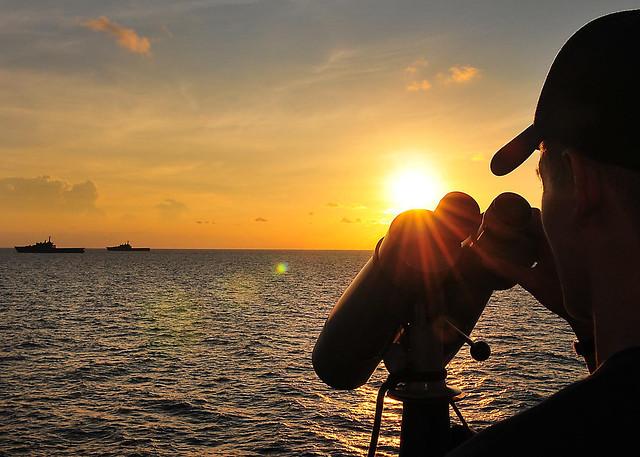
The term ‘Indo-Pacific’ reflects and frames surging strategic rivalry in the place we call ‘the region’.
The Indo-Pacific becomes a controversial label attached to a power contest.
As with any construct—political, social, diplomatic, strategic—it’s about who is doing the constructing and why.
The shift from Asia–Pacific to Indo-Pacific is more than a semantic geographic broadening. This is about mood swing as well as geopolitical forces.
Asia–Pacific became the descriptor du jour in the 1980s and 1990s. Viewed today, that was a time of sunny optimism: Cold War ending, US triumphant, globalisation glowing, China surging and Asia ever richer.
The region was at peace and the concept of the Asia–Pacific had a peaceful expectation. The Asia–Pacific was carried on the shoulders of business as well as leaders, with much of the shaping and shifting done by foreign and trade ministers. Diplomatic and trade perspectives plus optimistic regionalism built APEC and the East Asia Summit.
Today, the Indo-Pacific is driven by defence ministers and strategists. Leaders variously embrace the construct, avoid it or hate it. Diplomats divide. Business is bewildered. A darker era renders the Indo-Pacific in sombre hues.
China abhors the Indo-Pacific usage, a distaste shared by Russia.
The Indo-Pacific set includes the United States, Japan, India, Australia, the United Kingdom and France.
Southeast Asia stands uneasily in the middle.
ASEAN is labouring to produce a vision of the Indo-Pacific that can be embraced by all 10 members. Trouble is, the US proclamation of its ‘free and open Indo-Pacific’ strategy has electrified the construct, making it dangerous to touch.
How does ASEAN handle the free-and-open current that posits China as the alternating reverse—unfree and closed?
The jest is that ASEAN knows it’s too difficult to get a definitive concept of the Indo-Pacific; far better to stand outside to pick, poke and peer at the outlook. The play on concept versus outlook—being inside the idea or outside pondering it—draws on the language of Indonesia’s concept paper on the ‘Indo-Pacific outlook’. ASEAN can’t give a firm notion so much as express views and state hopes.
The exchange-of-views approach was how ASEAN reported the Indo-Pacific discussion in November when 18 leaders gathered for the East Asia Summit in Singapore:
We had a broad discussion on the various Indo-Pacific concepts. We noted ongoing discussions within ASEAN to develop collective cooperation in the Indo-Pacific region. We highlighted that cooperation in the Indo-Pacific region should embrace key principles such as ASEAN Centrality, openness, transparency, inclusivity, and a rules-based approach, in order to enhance mutual trust, respect and benefit.
ASEAN’s struggle and the difficulty of shifting from Asia–Pacific to Indo-Pacific flavoured speeches at this year’s Shangri-La Dialogue.
Singaporean Prime Minister Lee Hsien Loong’s keynote speech twice referred to the Asia–Pacific: once in describing the US as the dominant Asia–Pacific power after the end of the Cold War, and the other in talking about the coverage of a new free trade deal for the Asia–Pacific, the Regional Comprehensive Economic Partnership (no US role but not a bloc).
The Indo-Pacific got one passing, sceptical mention from Lee. Several countries had ‘proposed various concepts of Indo-Pacific cooperation’, he said, but these ideas were ‘less fully elaborated or implemented’ than China’s Belt and Road Initiative.
Cop that! China apparently is further ahead with the BRI build than others are with the Indo-Pacific construct. Talk about alternating currents.
Then Lee offered what I’d call a pointed description of ASEAN’s struggle with the Indo-Pacific:
We support regional cooperation initiatives which are open and inclusive platforms for countries to cooperate constructively and deepen regional integration. These initiatives should strengthen existing cooperation arrangements centred on ASEAN; they should not undermine them, create rival blocs, deepen fault lines or force countries to take sides. They should help bring countries together, rather than split them apart.
The speech by Malaysia’s defence minister, Mohamad Sabu, had three mentions of the Asia–Pacific: in the foundation of regional order, in ‘the realignment and restructuring of middle powers’ foreign and security policies’, and in the prediction that the uncertain relationship between the US and China ‘will remain as an implicit factor in shaping the stability of the Asia–Pacific region, particularly of Southeast Asia countries’. The Indo-Pacific got nary a mention.
By contrast, the Philippines’ defence minister, Delfin Lorenzana, embraced the new construct. He used Indo-Pacific seven times in his speech, with no mention of the Asia–Pacific. ‘The Indo-Pacific’, he explained, ‘is the new pivot of global geopolitics. It is where the future of the international order will likely be decided. This mega-region, however, is also a cauldron of unimaginably complex challenges, which will transcend the capabilities—and strategic imagination—of any single power or any limited grouping of nations.’
Going the other way, the speech by Vietnam’s defence minister, Ngo Xuan Lich, had seven Asia–Pacific mentions and zilch for Indo-Pacific.
Within ASEAN, Indonesia has been doing most of the pushing for an Indo-Pacific concept or outlook. Yet Indonesia’s defence minister, Ryamizard Ryacudu, managed only two Indo-Pacific mentions, with no sightings of Asia–Pacific. Southeast Asia is ‘a strategic maritime fulcrum in the Indo-Pacific’, he said, along with this expression of ASEAN centrality: ‘ASEAN is a concept and also a way, and the key to the stability of the Indo-Pacific region.’
ASEAN is loud about what it doesn’t want: blocs, fault lines and having to take sides.
The struggle is with an Indo-Pacific that shifts from geographic construct to an arena for contest—and the label for a US strategy.